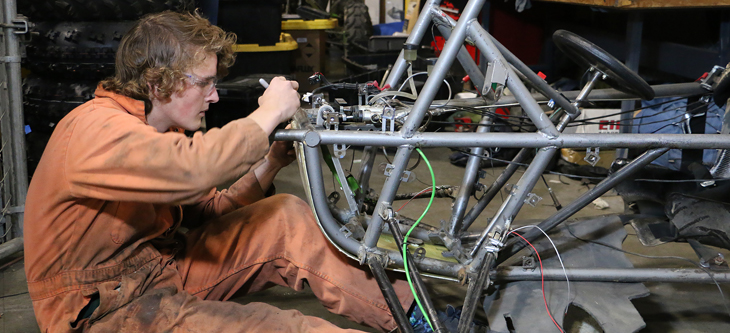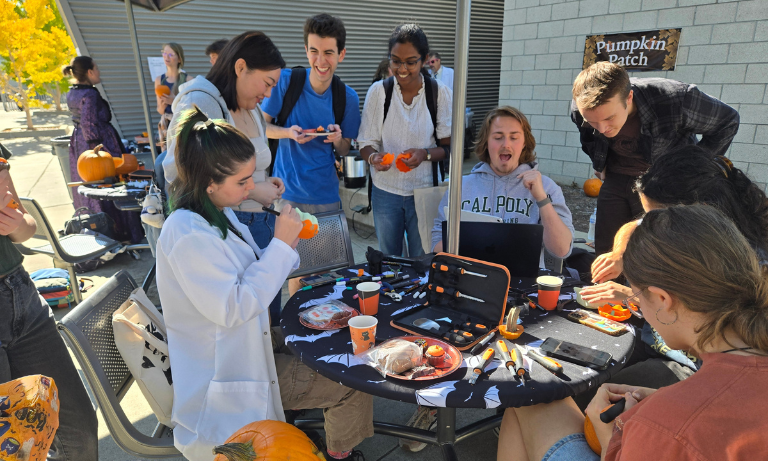Inside the metal Aero Hangar, Junior Gonzalez plops a metal gearbox onto a workbench, then begins tapping it with a rubber mallet.
“The output shaft isn’t quite fitting into the bearing right now,” explains the mechanical engineering major from San Diego, then resumes tapping.
Nearby, a Baja race car sits on two concrete blocks, stripped of most parts. But Gonzalez and the rest of the Baja race team are working hard to put the individual pieces together before a June 1 race in Oregon.
There are more than 125 members of Cal Poly’s racing team. Some of them build Formula SAE cars (electric and combustion), while others build Baja SAE cars. Some of the Baja students have been known to work 30- or 40-hour weeks on these cars throughout the year, preparing them for two yearly competitions.

The Baja event in Oregon consists of three static contests, featuring design and sales presentations and a cost report, and four dynamic events that test the cars performance — including a 4-hour race.
Team members tend to specialize on one aspect of the car, yet all the parts have to fit.
“The integration of everything means there’s a lot of teamwork,” Gonzalez says.
The team builds a new car every year. And, like any sports team, they analyze past competitions to see how they can do better.
“We have a bunch of wheel speed sensors on our car,” Gonzalez says. “That’s sort of like our videotape.”
Gonzalez, who has been off-roading since he was four years old, is no stranger to racing. But others have had less experience.
Robyn Ribet, a mechanical engineering major from Buellton, had no racing experience prior to last year.
“I’m not particularly into cars,” says Ribet, the team manager. “But I like building and facing problems and being able to solve them.”
Unlike the formula car, which races on a track, Baja drivers navigate through rugged tracks, with hills, water, rocks and dirt.
“You have to be able to go quickly but be really maneuverable and not tip over all the time,” Ribet explains. “
That’s where the right design helps.
Sitting at the front of the car in a greasy orange jumpsuit, Cameron Atwood, a materials engineering student from Lafayette, CA, holds up a skid plate he created and marks it with a pencil. The plate will protect the driver from rocks, but it can also slow the car.
“We chose composites because it’s lightweight,” he says, holding what looks like a bent piece of fiberglass. “It’s light, strong, cheap — and works.”
Before the races, the team tests the cars out at a couple of locations, one in Pozo and another in rural Paso Robles. Several different students drive the vehicle, and the ones with the best time end up driving during competition.
Will Antes, one of those drivers, knows the importance of keeping good speed. But he also wants to drive carefully, so the car doesn’t get damaged.
“You’ve got to be a little responsible with all these peoples’ efforts,” says the mechanical engineering major from San Jose.
During the last race, another driver landed on their car, breaking the wheel off. The team finished 18 out of around 100 drivers.
This time, they’re shooting for the top ten.
By 8 p.m. on a recent weekday, there are roughly ten students working on the car parts on work benches covered in gears, socket wrenches, and old bolts. Some of the students will be here until midnight, building a better beast.
“It feels like a full-time job,” Antes says. “But it’s a lot of fun right before competition.”


